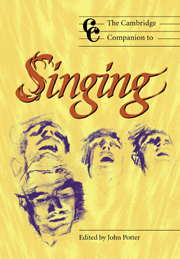Book contents
- Frontmatter
- 1 Introduction: singing at the turn of the century
- Part I Popular traditions
- Part II The voice in the theatre
- Part III Choral music and song
- Part IV Performance practices
- 12 Some notes on choral singing
- 13 Ensemble singing
- 14 The voice in the Middle Ages
- 15 Reconstructing pre-Romantic singing technique
- 16 Alternative voices: contemporary vocal techniques
- 17 The teaching (and learning) of singing
- 18 Children's singing
- 19 Where does the sound come from?
- Notes
- Select bibliography
- Index
14 - The voice in the Middle Ages
from Part IV - Performance practices
Published online by Cambridge University Press: 28 September 2011
- Frontmatter
- 1 Introduction: singing at the turn of the century
- Part I Popular traditions
- Part II The voice in the theatre
- Part III Choral music and song
- Part IV Performance practices
- 12 Some notes on choral singing
- 13 Ensemble singing
- 14 The voice in the Middle Ages
- 15 Reconstructing pre-Romantic singing technique
- 16 Alternative voices: contemporary vocal techniques
- 17 The teaching (and learning) of singing
- 18 Children's singing
- 19 Where does the sound come from?
- Notes
- Select bibliography
- Index
Summary
But of all musical instruments the human voice is the most worthy because it produces both sound and words, while the others are of use only for sound, not for a note and words.
This quotation from an anonymous thirteenth-century treatise is not alone in testifying to the pre-eminent role occupied by the voice in medieval music. The Christian church from the very beginning had rejected the use of musical instruments in worship both because of their intimate associations with pagan cults and because of their connection with the profligate immorality of the Greco-Roman world. Christian liturgical music thus developed in a direction consistent with, and determined by, the capabilities of the singing voice. The organ, an instrument difficult to construct and constantly in need of maintenance, made only gradual headway towards its eventual status as the sacred instrument par excellence. Few medieval churches could hope to possess so extraordinary a treasure. Instruments were tangential to the performance of monophonic secular song of the Middle Ages, and they seemed to have played only the most minimal role in secular polyphony.
The ‘early music’ revival of the twentieth century was guided primarily by instrumentalists whose imaginations could roam freely in the absence of instruments surviving from the Middle Ages. The human voice did more than merely survive: its physiology has remained unchanged, yet as John Potter observed, there was no re-evaluation of singing techniques comparable to the re-examination of playing techniques applicable to ‘period’ instruments. Instead, various twentieth-century vocal practices have competed for ‘authentic’ status, based more on the degree of aesthetic satisfaction they afford to twentieth-century ears than on their conformity with practices of the past.
- Type
- Chapter
- Information
- The Cambridge Companion to Singing , pp. 165 - 177Publisher: Cambridge University PressPrint publication year: 2000
- 2
- Cited by

